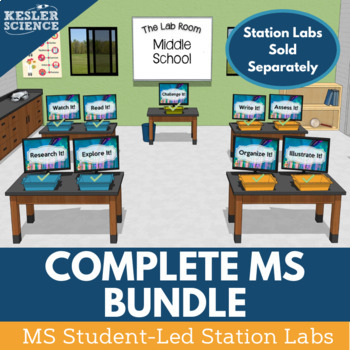Complete MS Science Student-led Station Labs Bundle - Differentiated Labs
- Various file types
- Google Apps™

What educators are saying
Products in this Bundle (103)
showing 1-5 of 103 products
Description
Student Led Science Labs - These comprehensive science labs will save you a TON of prep time and allow students to learn the concepts on their own. The Lab Bundle is a series of plug and play station labs designed to accompany my FREE Kesler Science Station Lab Series. Download the start-up guide to learn more about how to use it in the classroom. Each lab has 8 differentiated stations for the students to guide their learning.
Included in the Bundle:
BEGINNING OF THE YEAR
Newton's Laws (3 separate labs for each of the 3 laws)
Calculate Average Speed Using Distance and Time - calculate average speed from graphs and word problems
Work - determine work or not. Work = Force * Distance
Unbalanced and Balanced Forces - compare and contrast unbalanced and balanced forces
Net Force - calculate net force
Motion Graphing - graph motion using position/time and distance/time graphs
Graphing
Engineering Design Process
The Lunar Cycle
Tides
Solar System Arrangement and Planets
Day/Night, Seasons
Galaxies and Light Years
Life Cycle of a Star
H-R Diagram
Electromagnetic Spectrum
Eclipses
Asteroids, Meteors, and Comets
Big Bang Theory
Continental Drift Theory
Plate Boundaries
Properties of Minerals
Rock Cycle
Topographic Maps
Erosion and Deposition
Earth’s Layers
Density of an Irregularly-shaped Object
Density of a Regularly-shaped Object
Earthquakes
Volcanoes
Oceans
Fossils
Geologic Time Scale
Plant Cells and Animal Cells
Cell Theory
Dichotomous Keys
Characteristics of Organisms
Inherited Traits
Prokaryotic and Eukaryotic Cells
Sexual and Asexual Reproduction
Genetics: Dominant and Recessive Genes and Punnett Squares
Mitosis and Meiosis
Elements and Compounds
Structure of Atoms
Evidence of Chemical Changes
Counting Atoms and Elements
Metals Nonmetals Metalloids
Periodic Table Trends
Balancing Chemical Equations
Organic Compounds
Molecules
Chemical Bonding
Solids Liquids and Gases
Acids and Bases
Properties of Water
Conduction, Convection, Radiation
Energy Transformations
Potential and Kinetic Energy
Advantages and Disadvantages of Renewable Energy Sources
Advantages and Disadvantages of Non-Renewable Energy Sources
Properties of Waves
Visible Light (Reflection, Refraction, Diffraction, Absorption)
Photosynthesis
Electric and Magnetic Forces
Sound Waves (including doppler effect)
Weather Maps and High and Low Pressure
Hurricane Formation
Convection Currents
Catastrophic Events
Atmosphere
Water Cycle
Classification
Abiotic and Biotic Factors
Biodiversity
Biomes
Natural Selection
Organism Relationships (parasite/host, predator/prey, consumer, producer, decomposer)
Energy Pyramids
Food Chains and Food Webs
Short and Long-Term Environmental Impacts
Succession
Human Impact on Groundwater and Freshwater (watersheds)
Nitrogen Cycle
Carbon Cycle
Symbiosis - Mutualism, Commensalism, Parasitism
Turgor Pressure and Tropisms
Skeletal System
Circulatory System
Muscular System
Digestive System
Excretory System
Nervous System
Endocrine System
Respiratory System
DIFFERENTIATED LABS
There are 8 total stations for each of the labs (plus 2 signs for break stations if needed). Each station includes all of the signage, literature, resources, and task cards for the students to complete them independently or with a group. The labs will also require a few laboratory items that you likely already have in your lab for the Explore It! station.
The Stations:
Explore It! – This station will typically be a hands-on demo or experiment that allows the student to connect the information through application.
Illustrate It! – This station allows the student to sketch or draw out the concept that they are learning. This allows for better recall and retention of new information.
Read It! – At this station, students will find a short passage relevant to the content and have to answer 3-4 multiple choice questions about the reading.
Watch It! – Students will watch a short video at this station and answer questions relevant to their learning. This station can be setup with class computers/tablets, SMART board, or even a teachers computer.
Organize It! – The students will be working with a card sorts or manipulatives at this station. These are included with each of my units.
Write It! – At this station the students will be responding to 2-4 short answer prompts that will allow them to communicate their knowledge in complete sentences.
Research It! – This station will be a website that students will go to learn more information about the topic. Students will perform tasks and answer questions on their lab sheet. This station can be setup with class computers/tablets, SMART board, or even a teachers computer. If no computers are available you can double up one of the other stations and replace this module. Easy.
Assess It! – The students will demonstrate their knowledge of the topic using a series of task cards with more formal questions.
Distance Learning
The station labs now include files for your remote learning environments.
- Online Student Answer Sheet (using Google Forms) for every Station Lab.
- Distance learning directions PPT and video tutorial
- PDF of each on-level Station Lab without the answer key (can be sent to students)
- PDF of each modified-reading Station Lab without the answer key (can be sent to students)
- PDF of each Student Answer Sheet, rotated vertically, for those who cannot access Google Forms
Terms of Use
Copyright © Kesler Science, LLC. All rights reserved by the author. This product is to be used by the original downloader only. Copying for more than one teacher, classroom, department, school, or school system is prohibited. Permission is never granted to enter Kesler Science materials into any form of AI for any purpose. This product may not be distributed or displayed digitally for public view. Failure to comply is copyright infringement and a violation of the Digital Millennium Copyright Act (DMCA). Clipart and elements found in this PDF are copyrighted and cannot be extracted and used outside of this file without permission or license. Intended for classroom and personal use ONLY. Multiple licenses are available for purchase by departments, schools, or school districts. Contact chris@keslerscience.com for more information.





